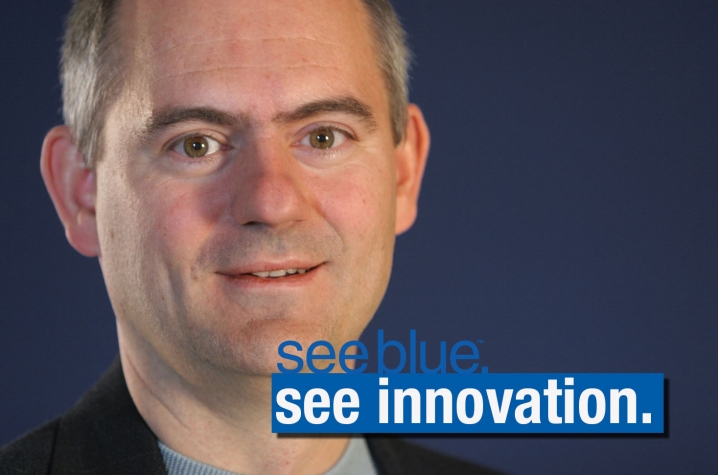Bringing Humanity's Treasures to a Worldwide Audience

LEXINGTON, Ky. (Nov. 15, 2013) — University of Kentucky computer scientist Brent Seales wants to use 21st century technology to preserve the treasured relics of humanity and make them accessible to a wider audience of scholars.
Seales, professor and chair of the College of Engineering's Department of Computer Science and former director of UK's Center for Visualization and Virtual Environments (Vis Center), uses state-of-the-art scanning techniques to produce high-resolution digital facsimiles of ancient artifacts. His work in applying computational techniques to problems in the humanities has brought him into contact with world-class museums and scholars on three continents. His early work included a project with the British Library working with digital images of the Beowulf manuscript. Subsequent projects included 3-D scanning of petroglyphs in Puerto Rico and the development of the use of micro-CT for digitization of damaged antiquities such as carbonized papyrus scrolls.
In 2007 Seales and his research team were allowed access to the Venetus A, the oldest known complete copy of the Iliad located in Venice, Italy.
"One of the goals of digitizing that manuscript was to make it globally accessible via the Internet, but we also wanted to combine the 3-D shape, the photography and the ultraviolet photography into one representation that could be manipulated and enjoyed by scholars," Seales said.
Later research trips to England, Spain and Taiwan have offered the opportunity to digitize additional antiquities. In many cases, the documents that Seales deals with are so fragile that digital scanning offers the best hope of preserving their contents for future generations of scholars, before they are lost to the withering effects of time.
Some imaging techniques, for example using x-rays or ultraviolet light, can reveal content that cannot be discerned with the naked eye. Under funding from the National Science Foundation Seales' EDUCE project (Enhanced Digital Unwrapping for Conservation and Exploration) sought to create readable images of texts such as papyrus scrolls, without opening them, using minimally invasive scanning and virtual unwrapping.
"It's important for the oldest things, for the most damaged things, for the things that tell us information that we haven't seen before," Seales said. "It's so important to capture that."
Ultimately, Seales believes that these and other precious cultural artifacts need to be made accessible to a wider audience of scholars, rather than being hidden away in a vault somewhere.
"When it comes right down to it, who really 'owns' a manuscript that was handwritten by monks more than 1,200 years ago?" Seales asks. "I think most of us, in academia at least, believe that these belong to humanity."
So, when Google Inc. invited Seales to spend a year in Paris as a visiting scientist, he jumped at the chance. In Paris, Seales worked alongside Google engineers on an emerging project called the Google Cultural Institute, which seeks to make precious cultural artifacts available to a global audience by putting them on the Internet.
For example, if you search Google for "The Starry Night," the results will include a Google "information card" about the Van Gogh painting. Click on the thumbnail photo and you'll be taken to a virtual Museum of Modern Art exhibit, part of the Google Cultural Institute. The exhibit includes a gigapixel-resolution composite image (made up of more than a billion pixels), which allows users to get a closer-than-in-person view of the painting, revealing tiny bubbles and cracks in the surface of the paint.
Seales says the information cards represent, in a small way, the capabilities of the enormous knowledge base that Google is assembling. Like a massive "Facts on File," Google's knowledge base is built to handle millions of billions of pieces of data (petabytes). Mapping out how those pieces of information are connected, and being able to anticipate their relevance in response to a query, is changing the way we think about Web search.
"We're moving away from a user submitting a query and the search engine returning a ranked list of documents, and we're starting to think of search as more of a conversation," Seales said. "When you do a Web search, most of the time you aren't looking for a list of documents. You're looking for the answer to a question. It's the difference between me telling you what you want to know, versus me saying 'Here's a stack of books. Look it up.' Really, what we want is for the search results to tell us a story."
The Google Cultural Institute provides a robust framework for storytelling, Seales says, allowing content partners and even individual users, to create "compelling and nuanced narrative presentations" using multimedia content that resides on Google's servers. The capability already exists for individual users to create their own virtual galleries and tell their own stories. To Seales, this represents the potential to democratize a vast trove of humanity's cultural assets.
"The underlying 'stuff,' the source material, I think that should be made available to everybody," Seales said. "What individuals do with it, in terms of their own scholarship, interpretation and presentation of the material, that belongs to them."
Seales' work with the Google Cultural Institute included implementation of a "Layers" feature, which enables users to view and compare two pieces of content by virtually stacking them on top of each other and crossfading back and forth between them. An example of the Layers feature, displaying a page of the Saint Chad Gospels as it was imaged across time, can be seen on the Vis Center's site at http://goo.gl/qKaajN.
In this coming together of physical, real-world cultural artifacts with modern, digital techniques for preservation, presentation and dissemination, Seales sees nothing short of a revolution in the way we think about research in the humanities:
"When you take that technological achievement and you apply it to fundamental problems in the humanities — understanding texts, reading material that's damaged — that broader confluence is fueling a transformation in scholarship that is unprecedented."
MEDIA CONTACT: Keith Hautala 859-323-2396; keith.hautala@uky.edu




